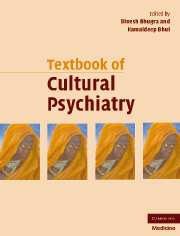Book contents
- Frontmatter
- Contents
- Contributors
- Foreword
- Preface
- Part I Theoretical background
- Part II Culture and mental health
- Part III Culture and mental disorders
- Part IV Theoretical aspects of management
- 26 Traumascape: an ecological–cultural–historical model for extreme stress
- 27 Sexual dysfunction across cultures
- 28 Therapist–patient interactions and expectations
- 29 Developing mental-health services for multicultural societies
- 30 Psychopharmacology across cultures
- 31 Psychotherapy across cultures
- 32 Psychological interventions and assessments
- 33 Spiritual aspects of management
- 34 Cultural aspects of suicide
- Part V Management with special groups
- Part VI Cultural research and training
- Cultural psychiatry: the past and the future
- Index
- References
33 - Spiritual aspects of management
from Part IV - Theoretical aspects of management
Published online by Cambridge University Press: 11 August 2009
- Frontmatter
- Contents
- Contributors
- Foreword
- Preface
- Part I Theoretical background
- Part II Culture and mental health
- Part III Culture and mental disorders
- Part IV Theoretical aspects of management
- 26 Traumascape: an ecological–cultural–historical model for extreme stress
- 27 Sexual dysfunction across cultures
- 28 Therapist–patient interactions and expectations
- 29 Developing mental-health services for multicultural societies
- 30 Psychopharmacology across cultures
- 31 Psychotherapy across cultures
- 32 Psychological interventions and assessments
- 33 Spiritual aspects of management
- 34 Cultural aspects of suicide
- Part V Management with special groups
- Part VI Cultural research and training
- Cultural psychiatry: the past and the future
- Index
- References
Summary
EDITORS' INTRODUCTION
The cultural aspects of managing a patient must take into account the spiritual models and explanations of the illness as experienced by the patients. For most of the last century, little attention was paid to religious or spiritual concerns of patients and their carers. The reductionist versus holistic approaches in clinical medicine allowed a degree of tension in management strategies, often detrimental to the patient. The religious beliefs were often seen as delusional and of interest to the clinician only in that context whereas spirituality was ill-defined and played an even smaller role.
Having discussed the implications of spirituality on the aetiology and presentation of psychiatric disorders by Lowenthal, in this chapter Sims deals with issues of clinical management and attempts to place spirituality in the centre of psychiatric management, fitting it into the complete picture of treatment of patients. Spiritual healing includes a number of strategies and would include spirituality at its core. Spirituality, according to Sims, has components of looking for the meaning in life, human solidarity (inter-connectedness of it all), wholeness of the person and moral aspects, along with the connection between God and man. Spiritual healing in the form of prayer, healing meditation or laying of hands has been noted in every culture. Sims offers a series of questions that need to be asked in taking a religious history from any patient. He emphasizes that ascertaining spiritual belief is also a vital ingredient of mental-state examination of the patient and gives valuable information for assessment and treatment.
- Type
- Chapter
- Information
- Textbook of Cultural Psychiatry , pp. 434 - 444Publisher: Cambridge University PressPrint publication year: 2007
References
- 3
- Cited by



